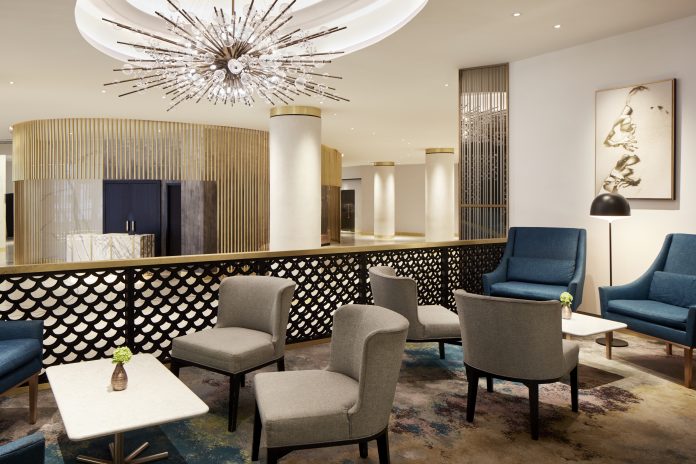
Over the past few years, lobbies have changed from check-in areas with little seating arrangements to full-blown immersive experiences, some with bars or even libraries where guest can sit in cozy chairs with front desk agents joining for checking-in. But each lobby is different, according to Lisa Simeone, one of two owners for Simeone Deary Design Group. She says, “It’s such a unique process for each location that to create something formulaic is difficult. Our approach tends to be similar, but the results are always unique.”
Simeone shared with LODGING some of the company’s steps for creating a lobby, potential challenges that can arise, and the importance of collaboration.
Researching is Key
Simeone Deary first starts with extensive research not only on the hotel and competition, but also on the location and history. Research includes the client’s goals, the competitive set, and what can be architecturally taken out of the property. Simeone says, “During that time, we are trying to mind the foundations for a compelling narrative. We’re doing everything from having our kickoff meeting with the client to understanding the given of a renovation project.”
Next, the company moves into putting the history, the era which the building was constructed, and any interesting, current facts about the location into what Simeone calls “comprehensive buckets” and layers those into the lobby based on importance. “We’re tending these days to look less at demographics and more at psychographics when we’re thinking about our guests and what their needs are,” she says. “there are some global needs as humans, but then there’s specifics. We’re also trying to incorporate experiential factors. This combination of these ideas makes a multifaceted nugget that we call our conceptual narrative.”
Creating Gateways to Experience
Lobbies can serve as entry and exit points to unique experiences in the area and lead to questions about surrounding restaurants, museums, and other places where guests can dive into a location’s history. Simeone says, “I could question my staff about the last hotel they stayed in and ask if they remember what the fabric was on the pillow on the sofa in the lobby and they couldn’t. But to remember the cool bartender that served this amazing drink that they came up with together, or to meet a local coffee roaster that had coffee pairings with the muffins they offer in the morning, those are the things we as humans take back and talk about.”
She continues that the lobby serves as a gateway to a successful stay at a hotel and says, “We look at our projects as holders. You have to have a great design or else every experience falls flat. You have to have a stellar space plan that allows for the perfect flow and amazing sight lines. You want the guest to see exactly what you want them to see and feel comfortable and relaxed enough in a space to let those experiences come in.”
Planning for Challenges
“There’s challenges all the time: scheduling, budgeting, having a vision that you bring everybody in on,” Simeone says. “The worst part is when you have all these parts and pieces and not everybody is on the same page collaboratively. It’s a collaborative effort. That’s an underlying challenge you have to mitigate all the time.”
Simeone Deary usually faces the most challenges with adaptive reuse and renovation projects, which sometimes have landmark priorities or architectural challenges that arise during demolition. Simeone adds, “You have to think very quickly on how you’re going to meet challenges, change with the changes that are occurring on a daily basis during demo, and keep your vision.”
Staying Away from Trends
Trends come and go, but timeless designs will always capture guest’s sight. Simeone relates this to the game 20 Questions, where a person walks into a lobby and already answers 20 questions in his or her head about the hotel, the design, and the location. It’s a make or break moment for a guest, and for hoteliers updating lobbies, having a design that can withstand the test of time and capture guests from the moment they walk through the door is critical.
Simeone says some trends that are sticking is front desks that aren’t front and center and morphing lobbies that can also be used as a communal working space. She says, “What’s not seeming to grab hold is the front desk going away completely. We’ve all been in hotels where we’re greeted by someone with an iPad and for some reason, it feels funny. I believe – myself personally – putting your stuff down, gathering yourself, getting your identification and credit card out, and having a pause but not doing a giant moment with a line of people behind you feels better.”
Welcoming Every Guest
Lobby design comes down to making guests feel welcomed, relaxed, and at home. It’s the space where a guest enters for and leaves a trip – the lobby is the last part of the hotel they’ll remember as they wait for a cab to the airport or a bus home. Designs, too, cannot be targeted towards generations or picked for a specific demographic. Lobbies are meant for every guest walking through the door, and designing for all is crucial to a hotel’s overall success.
“We just want to feel welcomed,” Simeone says. “We want to feel taken care of. We want to feel safe, and once we feel like those innate needs are met, we are free to take in different experiences, to experience what’s out there for us.”











